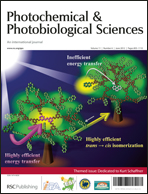The endoperoxide of mesodiphenylhelianthrene MDHPO has been studied in detail with respect to fluorescence and photo-induced rearrangement. MDHPO proved to be non-fluorescent, although its absorption spectrum is dominated at the low energy side by a strong ππ* band with a maximum at 429.5 nm. Irradiation of that band effects rearrangement to the corresponding diepoxide MDHDO, a reaction typical for S1(π*σ*) excited endoperoxides (EPOs). The absorption spectrum of the product MDHDO is blue shifted by only 3.5 nm. MDHDO has the same extended planar aromatic system like its precursor MDHPO, but MDHDO fluoresces strongly. These results set the excitation energy of the S1(π*σ*) state of MDHPO to ≤23 000 cm−1, which is considered to be a generally realistic value of the S1(π*σ*) state energy of aromatic EPOs. The main reaction of S1(π*σ*) excited MDHPO is, however, chemical deactivation to ground state MDHPO via an oxygen biradical. The sequence of O–O bond opening and closing is the general way of repopulation of the S0 state of aromatic EPOs from S1(π*σ*) excited states.

You have access to this article
 Please wait while we load your content...
Something went wrong. Try again?
Please wait while we load your content...
Something went wrong. Try again?


 Please wait while we load your content...
Please wait while we load your content...